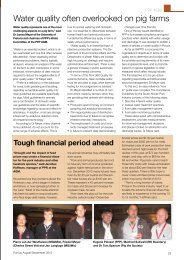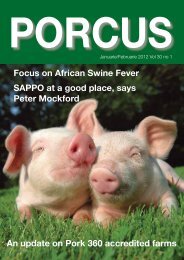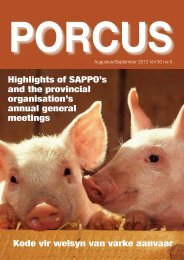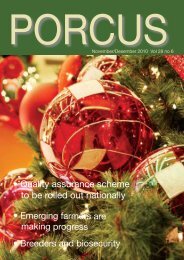porcus - sappo
porcus - sappo
porcus - sappo
Create successful ePaper yourself
Turn your PDF publications into a flip-book with our unique Google optimized e-Paper software.
8<br />
CS Vet INFORMAtION DAY<br />
One piglet per teat is the ideal<br />
“In every new-born litter, the ideal is<br />
to have one piglet per teat,” said Dr<br />
Andrew Tucker of CS Vet at the farmers’<br />
day.<br />
He said that increasing litter sizes and<br />
decreasing birth weight coupled with<br />
rapidly increased born alive has in most<br />
pig herds resulted in sows that do not<br />
have enough teats for all her piglets.<br />
Therefore, it is imperative to utilise every<br />
teat.<br />
Dr Tucker said some farms manage<br />
Low<br />
protein diets<br />
are cheaper<br />
Low protein diets reduce feed<br />
cost, reduce the amount of excess<br />
dietary amino acids, and create a<br />
balanced amino acid profile when<br />
first-limiting amino acids are sufficiently<br />
supplemented, said Friedel<br />
Meyer of CS Vet at the farmers’<br />
day.<br />
He said a low protein diet also improves<br />
feed conversion efficiency,<br />
while animals produce less ammonia<br />
gas emissions due to lower nitrogen in<br />
manure, which will improve the health<br />
and productivity of pigs.<br />
For every one percent drop in crude<br />
protein, the nitrogen excretion is reduced<br />
by approximately eight percent.<br />
As far as formulating tomorrow’s<br />
diets are concerned, the extent of<br />
reducing protein percentages in rations<br />
will depend on the price of soybeans<br />
and synthetic amino acids.<br />
Availability, price and nutritional value<br />
of alternative protein sources will also<br />
play a role.<br />
Enzymes such as non-starch polysaccharide<br />
(NSP) enzymes and protein<br />
digesting enzymes (proteases) will<br />
become more important when high<br />
fibrous by-products are used in pig<br />
diets.<br />
Meyer said that batches of raw materials<br />
should be analysed regularly for<br />
quality control and formulations have<br />
to be based on analysed values.<br />
to make use of all the sow’s teats, and<br />
outlined the following focus points:<br />
• The gilt’s milk must be stimulated<br />
properly, without burning her out.<br />
• The sow’s condition is very important<br />
to get intakes up. A fat sow has a<br />
decreased appetite, resulting in decreased<br />
weaning weights. However, if<br />
a sow is too thin, it may lead to stand<br />
overs.<br />
• The correct ration is important to fulfil<br />
the sow’s lactation needs, thereby<br />
maximising milk production.<br />
CS Vet’s annual farmers’ day<br />
took place outside<br />
Pretoria in October.<br />
• Count the sow’s functional teats and<br />
pack the piglets accordingly.<br />
• Minimise fostering.<br />
• Don’t size litters.<br />
• The piglet’s body temperature must be<br />
kept up at farrowing. Piglets should be<br />
dry and warm.<br />
• Get the piglet onto the teat as soon as<br />
possible once it is warm.<br />
• Cull poor producers. Look at the<br />
whole picture, and not only at born<br />
alive. Piglets weaned and the condition<br />
of the udder also plays a role.<br />
Mauritz de Villiers, Reon Oosthuizen en dr Albert Schutte (almal van Kanhym)<br />
De Villiers Beukes, Elizma Richter en William Gee (almal van Kanhym)<br />
Tommie Wolwehoek, Arno Spiske (albei van die Midland Groep) en dr Peter<br />
Evans (CS Vet)<br />
Porcus Oktober/November 2012







